Find out why....Everything You Know About Dinosaurs is Wrong!
Posted on Thursday, October 7, 2021
Category: Featured Authors
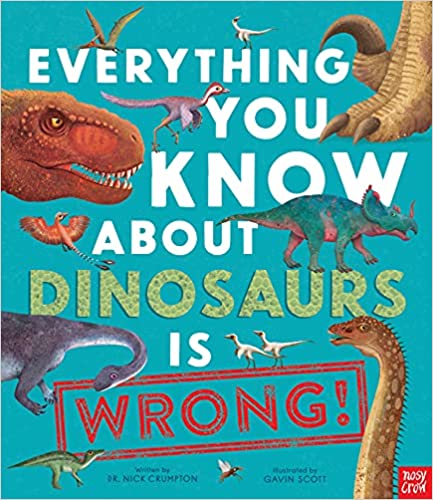
New research is overturning what we thought we knew about dinosaurs; Everything You Know About Dinosaurs is Wrong shares these new discoveries.
Everything You Know About Dinosaurs is Wrong (Nosy Crow)
September 2021
New research is overturning what we thought we knew about dinosaurs and in Everything You Know About Dinosaurs is Wrong, we learn how these new discoveries are showing dinosaurs in a fresh light. This is an ideal read for dinosaur-mad children, and a great non-fiction text to add to your shelves. Author Nick Crumpton and illustrator Gavin Scott tell us more!

Download an extract from Everything you Know About Dinosaurs is Wrong
Q&A with Nick Crumpton PhD
1. How did you start writing books about science for children?
I first began writing books about science for children during my PhD. I always loved explaining things to children when they visited the University Museum of Zoology in Cambridge and I'd jump to do any kind of outreach about zoology, so it was only a little step to the right for me to begin writing.
I loved how curious kids were about the things many adults glossed over in the museum, and how unusual their questions always were - I had to wear my thinking hat far more often when talking to children that to many of the students I supervised.
2. Have you always been interested in dinosaurs - why are we all so fascinated by them?
Yes! One of my earliest memories was learning the word "palaeontologist” and I would talk endlessly at my brothers about anything I learned about them. My parents were very supportive in collecting a weekly magazine about dinosaurs for me, and took me to see Jurassic Park in the cinema when I was far too young to have watched it (that opening scene!) but I certainly wasn't the only kid at school who was dino-mad.
I think so many children are fascinated by dinosaurs because they almost seem to be from another world - and yet we have proof that they once walked the same world we do. There's something akin to magic about them, or they're versions of animals from another dimension. To imagine these creatures in the same environment that we live in today is mind boggling. They just don't fit with anything we have around us today. No animal today fits into the same ecological niche as the enormous Patagotitan, and no predator reaches anything like the size of Allosaurus or Tyrannosaurus.
What adds another layer of weirdness to them was that the animals that live the most like them today are, generally, mammals - but these were reptiles. Their closest relatives today are crocodiles, alligators and birds which, for the last 66 million years, haven't approached anything like the diversity of forms seen throughout the Mesozoic.
3. What gave you the idea for Everything You Know About Dinosaurs is Wrong?
When Rachel Kellehar and Victoria England (who would later become my editor) invited me into Nosy Crow to discuss a dinosaur project with them, the idea for Everything You Know About Dinosaurs is Wrong appeared very quickly. The main inspiration for it were the discussions I had had about dinosaurs with children in the zoology museum, as well as hearing the inaccuracies their parents often told them, together with my experience of seeing first-hand how lightning-fast palaeontologists were adding to knowledge and overturning old ideas in scientific papers, conferences, and lecture series.
Palaeontology is all too often seen as a gateway science to 'more complex' or 'faster-moving' sciences, but I knew that to be a palaeontologist in 2021 was to be at the forefront of new imaging, geochemical and computational breakthroughs that could help us tiddly humans better understand the dizzyingly vast story of Life on Earth.
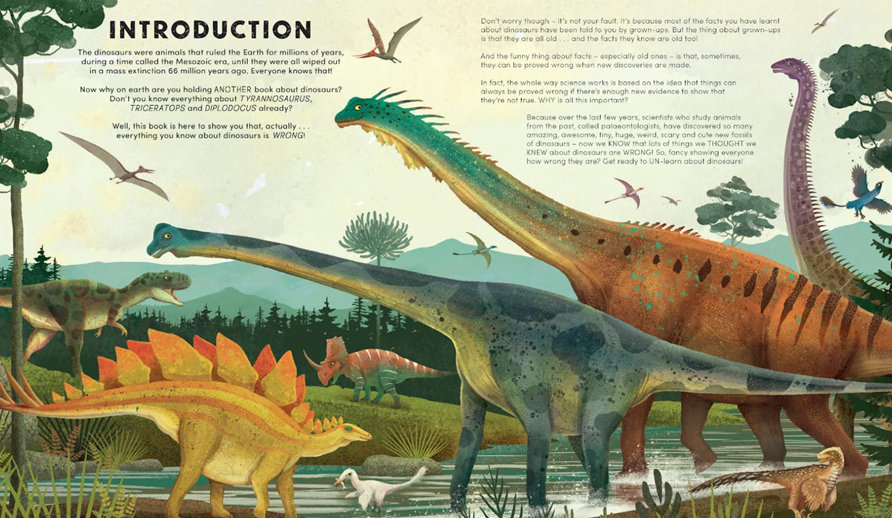
4. Can you tell us a bit about what is in the book?
The book takes 28 tropes about dinosaurs - "dinosaurs are only dug up in deserts”, "dinosaurs were cold-blooded”, "we've found all the dinosaurs” - and shows how recent science has disproved these statements, either partially or entirely. In a way, it's a miniature lesson on the fundamentals of science: the trope is a statement (a hypothesis) that can be disproved when evidence is analysed and assessed. The statements aren't just about dinosaurs, but also palaeontology in general as well as what being a palaeontologist is actually like day-to-day.
I was so happy we got the incredible Dr Susie Maidment of the Natural History Museum, London to act as scientific consultant for the book, and I went out of my way to include very recently discovered dinosaurs in the text as well as the headliners. There are many dinosaurs featured in this book that I know aren't in any other published children's book on dinosaurs and Gavin's illustrations are some of the most accurate reconstructions I've seen in any book, for children or adults alike.
5. What are your top three things we get wrong about dinosaurs?
I think the first is that people often don't understand the vast amount of time dinosaurs lived for and the extraordinary temporal distance between, say, Tyrannosaurus rex and Diplodocus. The second would be that all the theropod dinosaurs (the two legged, toothy-ones) ate meat (they didn't) but the biggest would be that we have found all the dinosaurs: we know about an extraordinarily insignificant number of dinosaurs when compared to how many must have once roamed the Earth.
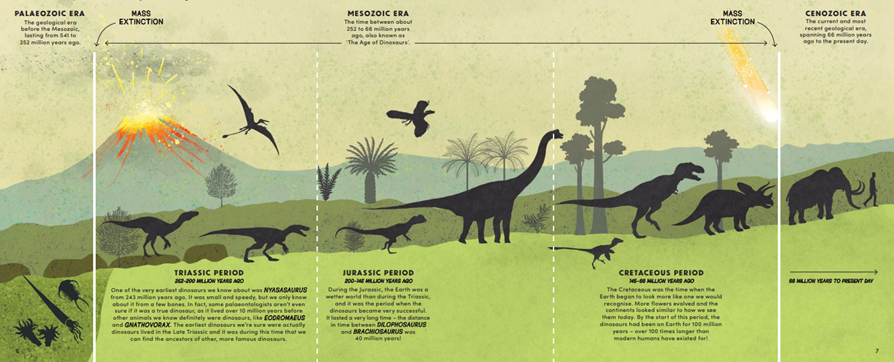
6. Did you need to know a lot about dinosaurs before you could begin to plan and write the book?
I'd worked as a palaeontologist for a spell, and my PhD was related in part to extinct animals, but my academic interest had always swayed me towards extinct mammals, rather than reptiles. But this being said, you could never work as a palaeontologist for even a short time without knowing a lot about dinosaurs, so I was able to develop the skeleton of the book extremely quickly thanks to years of talking about dinosaurs with my brilliant nerdy friends.
7. How much extra research into dinosaurs did you need to do, and where did you go to make sure you're up to date?
A lot! But that was because there is always new palaeontology news coming out week-by-week if you know where to look! I spent a few months with the broad outline of the book in my head devouring first every recent popular science book on dinosaurs, then more academic tomes. But the largest amount of research was spent surfing through academic journals and, if I needed to, contacting the authors and old colleagues of mine at universities and natural history museums to give me the low-down on the current state of knowledge about whatever aspect of dinosaur palaeontology I was currently researching. There's a lot in this book which is hot-off-the-press.
8. If you were able to recreate a dinosaur, which one would you want it to be?
Honestly, none. One of my favourite sections in the book is about how extremely unlikely it would be to 'bring dinosaurs back to life' and how many ethical implications are generated when you start thinking about what it would really entail. Sure, it would be neat to have a pet Protoceratops, but I'd much rather spend time and effort conserving and looking after the dinosaurs that fly around us today.
9. Where would be your top destination to go on a dinosaur fossil dig?
Anywhere in South America! There are some amazing finds coming out of that continent - like the Brazilian dinosaur Ubirajara - and South American palaeontologists are some of the coolest people. I'd love to tag along on a dig in Brazil, Argentina… anywhere!
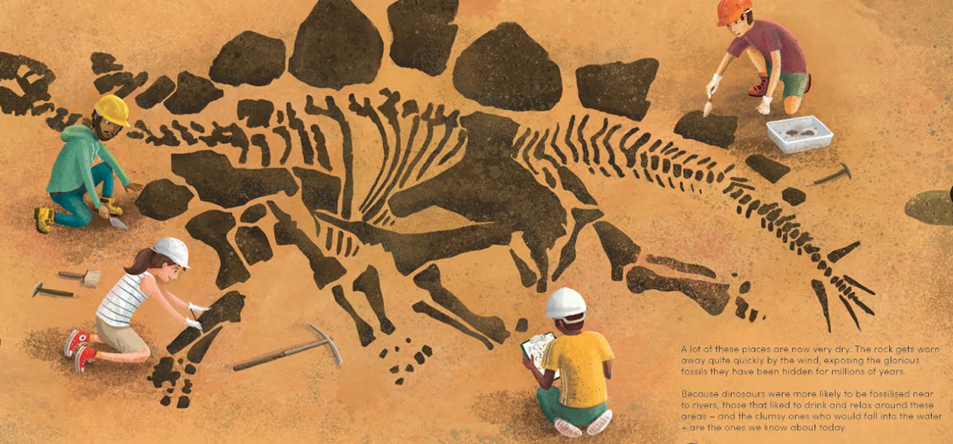
10. When you're not writing, what kinds of work do you do?
I work as a scientific consultant for publishers creating books about animals, and I also work for the UK's independent scientific academy, The Royal Society, in London. The coolest thing I do there is help award really amazing scientists prizes for incredible work they have done in their careers. I get to meet a lot of inspiring people and help them put on public lectures where they talk about their work in front of anyone that would like to see them speak.
11. What's your favourite way to relax away from your desk ?
I'm lucky to live very close to a beautiful ancient woodland in North London, and I love to go walking there with my partner and our toddler. It's full of raptors, owls, small mammals and insects. Even if I don't see
them, it's wonderful to know we are surrounded by them.
Q&A with Gavin Scott, illustrator
1. What do you mostly illustrate, and what do you most enjoy illustrating?
I mostly illustrate animals, both fiction and non fiction. When I was at art college I studied highly detailed/scientific illustration but my style is a lot different now. I don't really have one favourite subject, but dinosaurs are definitely hard to beat!
2. Why did you want to illustrate Everything You Know About Dinosaurs is Wrong?
I've always loved dinosaurs, since I was little (as a lot of children do!). It was a dream project that I just couldn't turn down.
3. What are your new favourite facts about dinosaurs?
That birds aren't just related to dinosaurs- they ARE dinosaurs! Scientists call them Avian Dinosaurs. So if you want to see dinosaurs alive today, just look out of the window! I also love the fact that there were sauropods (diplodocus type dinosaurs) that didn't grow much longer than 6 metres. The more you learn about dinosaurs, the more amazing things get!
4. How did you know what these dinosaurs might look like?
By researching each species and discovering what scientists have found out about them. There are some amazing fossils that give away so much information, including some soft tissue. For instance, Psittacosaurus had a flap of skin on the hind legs, and it was recently discovered that Spinosaurus had spiny bones on its tail. Facts like these change how the animal looks. I'm a children's illustrator rather than a paleontological one, but it was really important to me to be able to be as accurate as I could. It can be frustrating when new fossil evidence is discovered about dinosaurs that you've already drawn!
5. So is there a lot of guess-work involved when you're illustrating dinosaurs?
Yes, that's the great thing with dinosaurs, you're free to use your imagination to a certain extent- for instance with colour and patterns. I just had to make sure it tied in with the fossil evidence. There is an amazing Sinosauropteryx fossil which shows that it had a dark mask around its eyes, and scientists know that it was a chestnut brown colour. Also, some feathers are evident on dinosaur fossils, but to what extent some dinosaurs were feathered is not that certain. It's sometimes a bit of a guess!
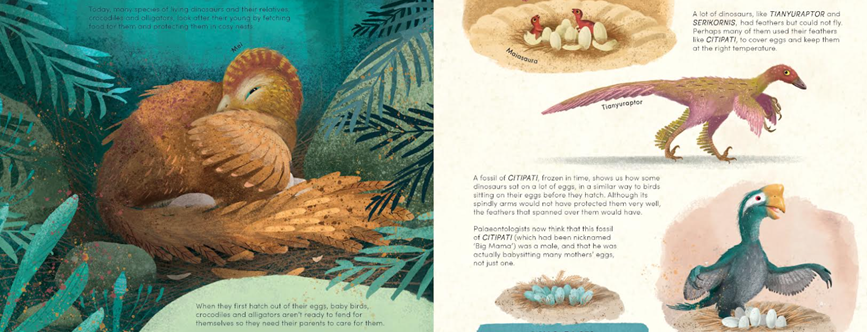
6. Did you also need to research the landscapes you put them into?
Yes I did. Flowers didn't really appear properly until the cretaceous period, and trees became more recognisable as modern trees towards the Jurassic period, so landscapes looked very different to the early dinosaurs compared to something like T-rex. Habitats varied between dinosaurs too, just like animals today. Some lived in forests, some in deserts, and even some in colder climates where there would have been snow!
7. How do you create your images?
I create mainly on the computer but combine that with a lot of painted textures, which I create by hand.
8. What other books are you currently working on?
I'm currently working on the follow up to Everything You Know About Dinosaurs Is Wrong which will be published next year. I can't say too much at this stage, but these creatures are a lot smaller than Dinosaurs- and just as fascinating!
